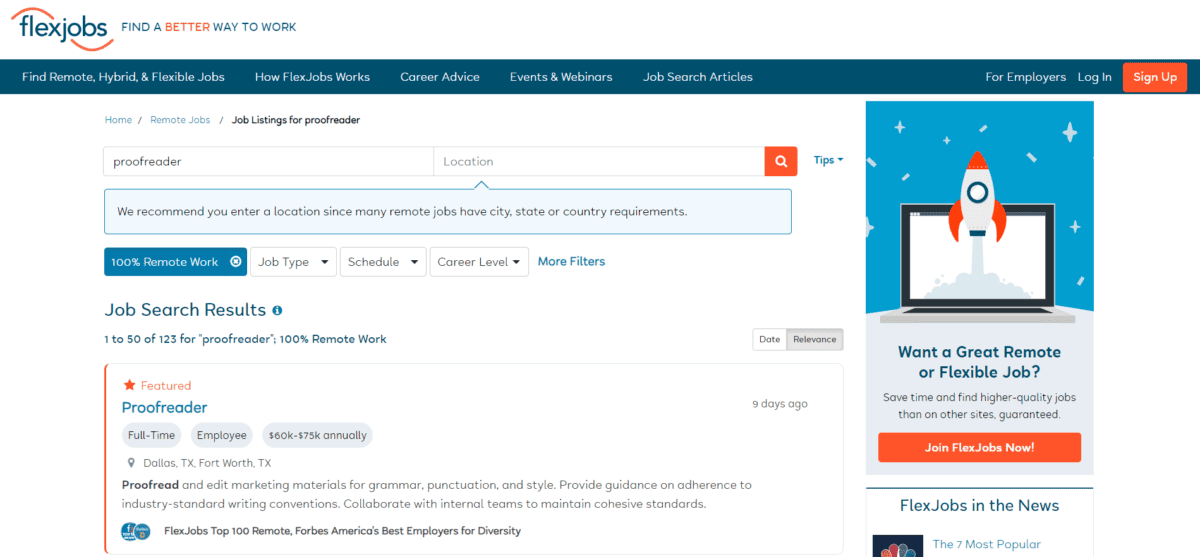This article may contain affiliate links. Please see our affiliate disclaimer in the footer menu for more information. Thank you for your support!

There are numerous ways for proofreaders to find clients, all of which require perseverance and patience. Let me be cliché by saying that finding proofreading clients is a marathon, not a sprint. You can think of this endeavor as a journey, not a destination. 😉
But the journey gets easier as it goes. Getting those first clients is the hardest part, but perseverance is your passport to making it happen.
We’ll start by looking at ways to get your own clients so you can set your own rates and keep 100% of the profits.
Then we’ll explore other ways of getting clients that are still valuable even though you may not be able to set your own prices or retain all the profits.
How to Find Proofreading Clients
1) Find proofreading clients by networking with proofreaders.
Other proofreaders can be one of your most valuable resources for finding proofreading customers. Proofreaders who network can answer each other’s questions and share strategies for finding clients.
You can connect with other proofreaders in Facebook groups.
For example, you can find a public group on Facebook called Proofreaders Group. The group is for proofreaders, those wanting to learn how to proofread, and people looking for proofreaders.
Being a member of a proofreading group gives you a support network.
LinkedIn is another prime place to network with fellow error eradicators.
For example, LinkedIn has a group called Between the Covers Editing and Proofreading Services (think book covers, not bed covers 😉). The group is for editors, proofreaders, aspiring writers, authors, and publishers.
I’m a member of the Proofread Anywhere GP Marketing Mastermind group—a private group for those who completed the General Proofreading: Theory and Practice™ course and scored 90% or above on the final exam.
At one point I had a proofreading job I couldn’t take, so I gave it to someone in this group. It wasn’t just a one-off job; it was an ongoing opportunity.
Joining these kinds of groups can be invaluable for landing proofreading customers.
2) Think about establishing a niche to attract more clients.
Proofreaders tend to establish a niche after getting experience with a wide variety of documents. After working with many types of texts, you’ll learn which ones you enjoy the most.
However, if you’re trying to get clients of your own, niching down from the get-go can be beneficial for marketing purposes.
People often look for a proofreader who is knowledgeable about a specific topic or type of document.
If you try to appeal to everyone, you may end up appealing to no one. By building experience in a niche, you’re more likely to connect with and get offers from those looking for your specific work.
Targeted testimonials will also help you gain authority and trust in your specialty.
I wrote an article on how and why to choose a proofreading niche if you’d like additional info. This post will give you lots of ideas for potential niches.
3) Join online groups where your target clients hang out.

After you’ve chosen a niche, you’ll know who your target clients are. Now it’s time to hang out where they hang out. Just as you network with other proofreaders, it’s also important to network with writers. After all, they’re the ones in need of your error-eradicating abilities!
Facebook and LinkedIn are two superb spaces for finding groups where writers congregate.
When you first join these groups, you’ll want to participate in discussions, share helpful advice, and work on building relationships. You don’t want to come off as desperate or “salesy.”
After you’ve provided value to the group, you can ask some of the writers if they hire proofreaders. If they do, you can let them know you’re available.
Top-Notch Tip: Take the opportunity to ask writers where they find the proofreaders they hire.
4) Cold email clients whose content you’d like to proofread.
Although not the most popular strategy, this tactic has survived the test of time because it still produces results.
Try to stay away from sending generic emails even though it’s much faster.
You’ll have a far better chance of success with thoughtful emails that you’ve customized for the recipient.
In your email, focus on how you can help your potential client. Tell them, specifically, how your proofreading service can benefit them. I wrote a listicle about why proofreading is important if you need ideas.
Of course, you’ll want to use a ton of tact in your email and refrain from pushing your services too hard. If you like their work (blog post, book, etc.), tell them. Who doesn’t love a genuine compliment? 😊
Finally, although I generally don’t advocate working for free, it may be necessary initially. Some proofreaders offer to proof a short document for free in exchange for a testimonial and referral. You could also use this strategy in the writer’s groups I mentioned.
Not everyone will want to take the work-for-free approach. But if you’re comfortable with it, you can reap some rewards while getting more practice proofreading.
5) Set up a profile on LinkedIn.
Establishing a LinkedIn profile is another wonderful way to market your business. Make sure to fill out your profile completely and focus on a niche.
The people searching for a proofreader on LinkedIn typically aren’t looking for just any proofreader; they’re looking for a proofreader who specializes in the kind of content they need polished.
Focusing on a niche makes it much more likely you’ll be contacted.
If you’re open to the opportunity of doing freelance work for a business, make sure your profile is searchable by recruiters and hiring managers.
Also, keep in mind that LinkedIn has a job board! The job board lets you set a filter to show remote opportunities only.
6) Create a Facebook business page.
Having a Facebook business page is another great way to advertise your business. If you’re interested in taking this step, here’s a helpful video from Santrel Media that clearly explains how to create a Facebook business page.
7) Build a website for your proofreading business.
Even though this takes some time and a bit of money, having a website makes you look more professional. Establishing a site shows you take your work seriously.
Your website provides a space to list your qualifications and the testimonials you’ll get for the stellar service you deliver!
I wrote a post about how to start a proofreading company that discusses the information to include on your website’s pages.
You can put your site’s address on your LinkedIn profile and other social media sites where it makes sense to advertise your services.
You can also put the link to your website on your business cards.
Having business cards made is another way to get your name out there. The more exposure, the better!
8) Let family, friends, and others know you’re taking on clients.
Be vocal about what you do so word of mouth can work for you!
Tell your family and friends you’re looking for customers so that they can recommend you. Make an announcement on social media platforms where you’ve established a network.
If your network of family, friends, and acquaintances knows you’re for hire, you may land a client by word of mouth, even if you’re just getting started.
9) Consider where you’ve worked or volunteered recently.
If you currently have a job, you may want to tell your boss and coworkers you’re on the lookout for proofreading work on the side.
And if you’ve worked or volunteered somewhere in the past that could benefit from having a proofreader, you can let them know you’re available for hire. Since you’ve already earned their trust, they’ll be more likely to consider using your services.
10) Always ask your proofreading clients for a referral.
Try to dazzle every client you work with! Your effort will be well worth it since they’ll likely hire you again if you knock their socks off. It will also make it easier for you to ask for a referral.
And since you’ve done such fabulous work for them, they’ll probably be happy to pass your name on to anyone needing a proofreader.

Also, if you’ve established a solid relationship with your client, you may want to ask for a testimonial.
Finally, don’t forget to connect with former clients. Let them know how much you enjoyed working with them in the past and how you can help them going forward.
11) Join your national editorial organization.
Although you ordinarily pay a fee to join one of these organizations, it can be worth it if you have the funds. You’ll be able to network with other proofreaders, including ones who are well established in the industry.
You can learn a lot from your more seasoned colleagues!
Editorial societies usually have a directory for proofreaders and other editorial professionals.
Being on the list will put your name and services in front of those looking for a pair of eagle eyes.
Some editorial organizations have requirements for membership. If you can’t join one now, you may want to consider doing so in the future.
12) Get proofreading clients by searching popular job boards.
Searching job boards is another way to find clients. In this case, your future client would be a business. Although most job boards feature listings for on-site work, some feature work-from-home opportunities.
You can find these off-site opportunities by typing “remote” into the job location search bar.
Here’s a list of job boards that have remote listings:
You can use all these sites for free except FlexJobs. FlexJobs requires a subscription fee since they screen every job posted on their site to ensure only legitimate and professional opportunities.
Here’s a job offer that popped up on FlexJobs when I searched for remote proofreading positions:

FlexJobs is a super site, and so is Glassdoor. I like Glassdoor because you can find out how employees and freelancers rate working at a particular company. You’ll be able to spare yourself a headache by not applying to businesses that have received poor ratings.
13) Check out job boards geared toward bloggers.
Occasionally, you may find a proofreading job on one of the two most popular job boards for bloggers: ProBlogger and BloggingPro. I’ve discovered more relevant jobs on ProBlogger than on BloggingPro, so that’s probably your best bet.
If you’re also a writer, the jobs on these boards may be right up your alley. I’ve seen several hybrid opportunities where a proofreader with writing skills is needed. For example, the freelancer may be in charge of proofreading articles and adding or improving content when necessary.
14) Consider online proofreading and editing companies.
You can find numerous online proofreading and editing companies that hire proofreaders.
If you’re interested in working remotely for one of these businesses, you may want to check out my article “20+ Best Online Proofreading Jobs for Beginners in 2024.” I spent a ton of time doing research for this post by finding companies that actually hire proofreaders.
Many businesses offer proofreading and editing services but only hire editors who are also responsible for proofreading.
Furthermore, the terms editor, copy editor, and proofreader are often so loosely defined that it can be difficult to determine what skills someone needs to get hired for a particular position.
The article I wrote includes legitimate proofreading jobs.
15) Create a profile and pitch to clients on freelance platforms.
Another option for finding customers is to set up a profile on one of the following popular freelance marketplaces:
- Upwork
- Freelancer
- Guru
- PeoplePerHour (must apply)
The advantage of these websites is that the marketing is done for you. Lots of potential customers will see your profile. These clients usually seek someone for a one-off job; however, some return as the need arises. Also, the marketplaces manage payments.
The downside is that you’ll face a lot of competition and have to give a small percentage (typically 10%–20%) of your earnings to the platform.
Also, you’ll likely need to start with low rates to attract clients, but you can raise your prices after getting more traction.
Finally, you’ll have to send a written proposal to try to “win” each job you’re interested in.
Although it’s challenging to land your first batch of clients, these sites can be excellent places to get proofreading work. They allow you to obtain the experience required to qualify for higher-paying jobs in the future.
Two keys to success are sending tailored testimonials that focus on what you can do for the client and being one of the first freelancers to respond to an RFP (request for proposal).
Of course, the more proposals you send, the better your chances of landing a job.
Top-Notch Tip: The best way to avoid scams is to only communicate with clients through the means provided by the platform.
16) Offer various proofreading gigs on Fiverr.

Fiverr is another freelance marketplace where you can set up a profile. As usual, getting your first few clients is the hardest part. You’ll have to give 20% of your earnings back to Fiverr, but you won’t have to write a proposal for each job you want.
On Fiverr, customers usually come to you if they’re interested.
I began my proofreading career on Fiverr and got a ton of experience proofreading a wide range of documents. As mentioned, you need to start with low prices to attract clients.
I published a comprehensive article about how to succeed on Fiverr as a freelancer. The post is geared toward proofreaders, of course 😊, and it details all the strategies that allowed me to succeed on Fiverr.
I think you could benefit significantly by implementing the tips in that article if you choose to create a Fiverr profile.
17) Find a company that offers a guaranteed work placement.
Knowadays, a business that offers online courses, provides the possibility of guaranteed work (but it’s both proofreading and editing work) to those who qualify.
If you’d like to learn about the requirements to qualify for the work guarantee, I discuss them in my article about Knowadays’ principal course.
I wish you the best of luck finding clients for your proofreading business.
Remember that patience and stick-to-itiveness are the keys to getting freelance proofreading clients!
Best wishes to you!
“Everything is energy, and that’s all there is to it. Match the frequency of the reality you want, and you cannot help but get that reality. It can be no other way. This is not philosophy. This is physics!”
– Albert Einstein

Recent Posts
Punctuation is important because it enables us to communicate our message clearly and effectively. Without punctuation, we wouldn’t understand how units of a sentence relate to one another or how...
Although you're probably somewhat familiar with adverbs, you may be unaware of sentence adverbs. As a trained proofreader who has studied the parts of speech, I can help you understand this unique...
